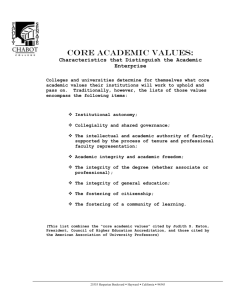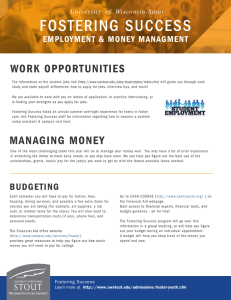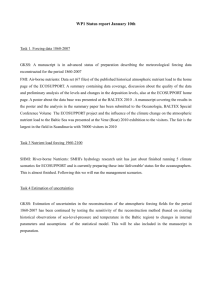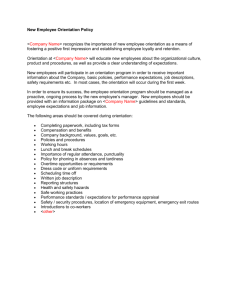-1 August, 1995 SWP 3841
advertisement
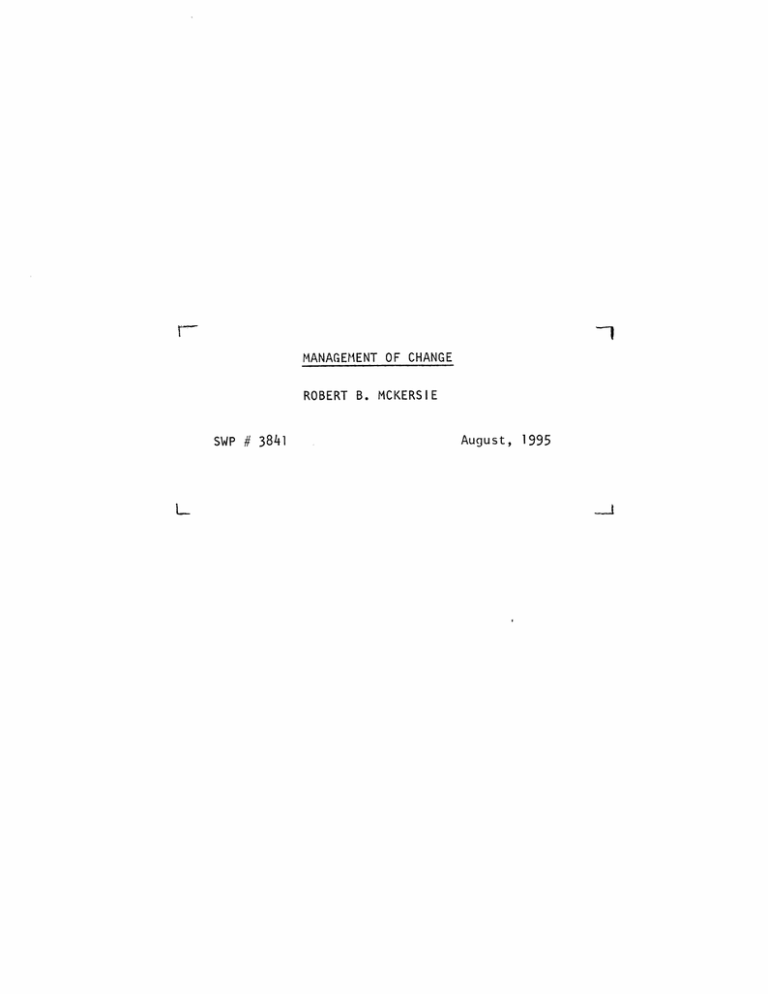
-1 MANAGEMENT OF CHANGE ROBERT B. MCKERSIE SWP # 3841 L August, 1995 __ REVISED DELIVERED 6/30/95 AT THE 1995 NTU-MIT ANNUAL CONFERENCE SINGAPORE MANAGEMENT OF CHANGE ROBERT B. McKERSIE Society of Sloan Fellows Professor Sloan School of Management Massachusetts Institute of Technology Cambridge, Massachusetts MANAGEMENT OF CHANGE INTRODUCTION I am extremely pleased to be here in Singapore and to meet so many people who are associated in so many different ways with different parts of MIT. Since I chair the faculty for the Sloan Fellows Program, let me make a few comments about this connection. For the past several years, each class (numbering approximately 55 students) has counted in its makeup three or four middle managers from Singapore. I can say without hesitation that they are some of our best students in this one-year degree program. They bring experience in both your public and private sectors as well as keen minds and leadership qualities which we benefit from immensely. This past year we celebrated Singapore Independence Day with a wonderful luncheon that they organized. Let me continue in a personal vein and express my delight at returning to this remarkable country after an absence of over 40 years. I was here in the early 1950s courtesy of the United States Navy. The city at that time was in my brief glimpse a combination of cricket fields and thousands of boats lining your waterways that housed large numbers of your population. The amount of change that has taken place since then is truly monumental, and I am overwhelmed by the changes that have occurred. The timespan of 40 years has been used by a number of writers to dramatize the tremendous reordering of the business scene in what, in terms of history, would be a short period of time, just twoscore years. The material for this talk comes from several research projects and educational programs in which I have been heavily involved over the past several years. At the Sloan School, we now have a center headed by Peter Senge entitled "Organizational Learning". We also have a very successful joint program between Sloan and the Engineering Department to train talent for manufacturing. This latter program, entitled "Leaders for Manufacturing," has restored interest within our MBA program for careers in manufacturing management. I chair a research group that is jointly sponsored by the Organizational Learning Center and the Leaders for Manufacturing program that is examining in a set of companies a number of projects within the broad subject area of organizational change, culture, and learning. We have just completed a seminar that emphasized field studies, culminating in a one-day conference to summarize our findings with reports to the sponsoring organizations. This model of orchestrating field research around a common theme and beginning to build a body of knowledge is very powerful. The second touchstone for my remarks is the book recently completed on the subject of strategic negotiations. Dick Walton of Harvard Business School and Joel CutcherGershenfeld of Michigan State University and I studied change efforts in three industries and analyzed these programs from a negotiations point of view. I will have much more to say about our perspectives shortly. A third reference point is direct experience in an emerging partnership between the United Steelworkers and Inland Steel where I serve as a union-designated director. THE CONTEXT Before plunging into a discussion of my topic, managing change, I want to say a few words about the context. I do not have to belabor the point that today the baseline assumption is that change is pervasive and unending. Apparently, the only thing that is not changing is the necessity for change itself. What has brought about this state of affairs? First, we have become a contracting society. Organizations are constantly being restructured and realigned with new partnerships and alliances. Even within the core area of employment, more and more workers are being hired on a temporary basis. Whether we use the image of the horizontal corporation, the virtual corporation, or as one of our new centers at MIT labels it, the 21st century corporation, we are talking about a business system that has pieces that are being put together in new configurations on a very rapid and dynamic basis. Second, some of you may feel that the first point is overstated and that many organizations remain rather stable and could be considered reasonably traditional. This characterization may be accurate to some extent. However, I firmly believe that stability is only temporary and is only a superficial description of what is happening in our society. The pressures for change are immense in just about all sectors of business -- and for that matter, also in the public sector. Companies are constantly benchmarking themselves against competition, and global markets are putting pressure on all industries, even those that for many decades have been reasonably sheltered. Even new enterprises that often had a period of stability because they are able to put the latest practices into place when they commence operations, find themselves needing to modernize if they are going to remain "world-class." What I am saying is not new to a country like Singapore which has continued to modernize itself at a very rapid rate. What may be of some relevance is the experience of companies in a number of key U.S. industries -- specifically, how the organization side is modernized at the same time that the technology and the hardware side of the organization are modernized. Introducing new technology is a rather straightforward process. However, modernizing the organizational design, the skills, and structures affecting workers is nowhere near as straightforward. It is to this important subject that this paper is addressed. THE NEGOTIATION PERSPECTIVE ON THE CHANGE PROCESS The fundamental perspective of my presentation is that the change process can be very usefully viewed as a negotiation process. Let me identify some of the advantages of viewing -2- change as a negotiation. First, it forces attention on identifying the interests of all parties and not just what people at the top of the organization think is necessary and desirable. We use the concept of stakeholders to identify all parties of interest. Second, in terms of key stakeholder groups, certainly employees are key stakeholders but their union representatives are equally important. Change only happens when all members of the organization take ownership, become committed, and drive the change process. In this sense, the management of change refers to the reality that all stakeholders are part of the management process. Some individuals may have more visibility because they are at the top of the organization chart (for example, executives). However, the guiding premise is that management is a process that is too important to be left just to the executives. It needs to involve all members of the organization and their representatives. In the U.S. today, in an increasing number of industries, unions are playing a very positive role with respect to change. In some instances, the presence of a union and the ensuing negotiation process may mean that it takes longer to design and execute the change, but it is much better to have the issues brought out in the open through collective bargaining than for management to assume that the workforce is on board, only to later learn that what appeared to be support was only bland acquiescence to the new structures and policies. How We Think About the Negotiation Process. We distinguish two key dimensions, namely, the substantive content as well as the social or attitudinal content of negotiations. And in line with these two dimensions, we identify two distinct strategies, namely, a forcing approach to change that places primary reliance on achieving substantive change, and a fostering strategy that places primary emphasis on changing social relations and attitudes. Together, these two strategies capture the twin requirements of direction and empowerment -- without which the change process will not be effective. The Function of Forcing. The forcing strategy seeks to realize the vision of what is desirable by way of a change from the present state. It places heavy emphasis on maintaining control and assuring that the change process meets specific goals and timetables. In terms of U.S. experience today, it is most closely associated with downsizing and cost reduction. The Function of Fostering. With its emphasis on building better relationships and social capital, this strategy embodies the value-added dimension of change. There is more emphasis on a quality result that can only be delivered if the total organization is involved and empowered. Because this strategy emphasizes attitudes and readiness for change, it pays more attention to the feasibility side of change. -3- The Limitations of the Forcing Strategy. By itself, the forcing strategy often runs into substantial resistance to change. In our case studies, we have dramatic examples where executives formulated a plan of change and then attempted to drive it in place, only to produce an escalation sequence where there were strikes and unending dynamics of move and counter-move. In such instances, employees do not cooperate and unions view the proposed change as a threat to their very institutional existence. Limitations of the Fostering Strategy. On the other hand, if pursued singly, the fostering strategy can produce better attitudes and a "good feeling" but nothing else happens and the parties remain locked in the status quo as far as work rules and organizational structures are concerned. We studied several cases where the parties interacted frequently and improved relations, but never succeeded in settling substantive matters that would make a difference for the long-run viability of the enterprise. TOWARD A SYNTHESIS Clearly, the best approach to managing change is a combination of forcing and fostering. In this sense, our view of change posits that it is a mixed motive process. However, while it is possible to conceptualize a synthesis of forcing and fostering, it is very challenging in practice to combine these two polar strategies. It is to this task that we now turn. Basically, best practice keeps these two strategies distinct either in a time, structural, or organizational sense. We first consider the time sequence for the change process, starting with the first phase, the precipitating or unfreezing process, then the design phase, followed by the implementing of the agreed-upon changes. Two ultimate steps in the time continuum are also involved: sustaining the change, and expanding it to similar situations. PHASE ONE: CREATING THE IMPETUS The literature on organizational change is replete with the notion of an unfreezing event, or something that creates a significant emotional experience so that sufficient elements of the organization experience the need for change for a sequence to begin. In terms of the stated strategic alternatives, this first phase often has a significant element of forcing, because some key individuals are more aware of the threats or opportunities than others in the organization. Quite importantly, a significant emotional event may not always be a negative development, but could also be a positive one. In one of our recent case studies (EDS), top management held the view that if they were going to maintain their lead position, they needed to bring about a transformation of human relationships within the organization. Thereupon, they convinced a cadre of individuals to enter into a program that contained many elements of -4- what, back in the 1960s, was called "sensitivity training" and "T groups". As a result, a very fundamental alteration of the underlying social structure was set in motion. More frequently, the message contains threatening elements in which key leaders say to the organization, "Unless we get some changes, then we will have to resort to our alternative," which might be selling the business, opening a new plant -- all forms of escape from the current situation which is viewed as untenable over the long run. In the lexicon, called a BATNA: the Best Alternative To a Negotiated Agreement. Or economists would call it the "reservation price." While the first phase contains heavy elements of forcing, there are also opportunities for fostering and maintaining a workable relationship. Indeed, the use of data and the focus on the customer usually helps the organization see the situation not just as something that key executives have foisted upon them, but as a reality that needs to be encountered. The litmus test for this first phase of the process is whether the rationale for change is credible. Often, resistance to change is not emotional but is rational, and represents stakeholders saying they are not convinced about the need for a change -- rather, they may view management as only trying to increase short-term profits, i.e., serving the immediate interests of stockholders and not serving the interests of the total organization. However, if the case can be made in terms of the necessity to increase resources in order to reinvest, with the resulting benefit for all parties, then the credibility test can be met. The most successful strategic approach for the first phase results in what we call "restrained forcing." By this we mean that key managers exhibit a determination to move forward with a change program, but they do it in a way that maintains working relations within the organization. It is possible that some employees and, indeed, perhaps even union representatives may seek to stand in the way and even attempt to galvanize opposition. In this respect the union, as a channel of communication can, in the short run, appear to impede the unfreezing process. Best practice involves a determination to move ahead, providing considerable information, and involving key elements of the organization. In one of our cases, the CEO took a group of machinists to a trade show to see the latest technology and work organization that their company would be competing against in the future. This became an "eye-opener" for these key craftpeople and set the stage for the negotiation of an entire new work system. PHASE TWO: DESIGNING THE NEW SYSTEM In terms of our framework, the second phase embodies heavy elements of fostering or problem-solving. The challenge is to uncover new alternatives and to identify what are often called "win-win" arrangements. A dramatic example is the design effort that resulted in the Saturn enterprise. In this instance, a committee of 99 individuals made up of a cross-section -5- of management and union people met over the course of several years. By taking "the blank piece of paper" approach, they were able to agree upon organization and technological specifications that has produced a very impressive model of the 21st century enterprise. As many distinct interest groups within the organization need to be involved as is practicable. Middle managers often feel left out of the process and in one of our case studies, considerable attention was paid to coalescing support and tapping the know-how of middle managers. The same is necessary on the union side and in one of the railroad examples, a group of regional chairmen who had not been involved ultimately rejected a very comprehensive package for change, making it impossible to go forward. Of course, a setback on the first ratification attempt does not mean failure. In fact, employers who have persevered and gone back for second votes, and in some cases even third votes (fine-tuning the plans along the way), generally have been successful. It is the old adage, "if you do not at first succeed, then try, try again." Those who support the new arrangements remain steadfast and as the process of education continues and adjustments are made, new support develops and eventually it is possible to secure a majority in favor and move forward. Clearly, it takes patience and often a longer timetable than originally envisioned to navigate the ratification process. Developing a win-win package takes considerable imagination. In the case of the railroad example (that failed), primary emphasis was placed on employment continuity and sharing the gains on a continuing basis. An additional factor in its demise stemmed from the design of the gainsharing that did not resolve disparities between attrition and savings over the long run. In one of the cases from the paper industry, the design was successful because management focused attention on changing the work system and not pay levels. In fact, it was possible after the implementation of the new system for workers to increase their pay due to new skill competencies. PHASE THREE: IMPLEMENTING THE NEW REGIME This phase involves a very intricate mixture of both forcing and fostering strategies. Effective implementation requires measurements and timetables. Forcing is required to establish direction and a determination to realize results against specified milestones. At the same time, the fostering strategy is required for implementation to be successful, especially the mobilization of the organization and the creation of momentum for change. These elements are often achieved by extensive training and the presence of facilitators, e.g., project leaders. Many of the programs that we have examined involve the use of teams and the creation of greater responsibility at lower levels in the organization. In effect, the pathway to change gets managed by those who are closest to the change itself. -6- In the steel company where I serve as a director, we have found that implementation is helped by the availability of a "toolkit." Members of the organization are trained to use very specific methodologies for problem-solving, for the attainment of quality objectives, and for handling the critical maintenance function. These protocols help regularize the new behaviors that the restructured organization requires. New governance arrangements that provide oversight for the implementation process also play a crucial role. In the case of Chrysler with its MOA systems, and Inland Steel with its partnership, several steering committees help monitor progress and provide a forum for the recalibration of the implementation process. Nevertheless, "bumps in the road" usually are encountered. These can be thought of as pivotal events, where progress is stalled, with the parties facing the alternatives of a serious weakening of the change effort or viewing the problem as an opportunity to realize a more effective implementation process. In other words, many choice points occur along the way. Clearly, the negotiation process is a continuing one, and the parties must deal regularly with difficulties that were not originally anticipated. SUSTAINING THE CHANGE EXPERIENCE Companies that have made the most progress in managing change have built into the process mechanisms that keep the organization focused on the change journey. In the case of Kodak, departments are required to develop plans for all employees that commit one week each year to training for each employee. Carrying through on this commitment means that the organization is continually adding human capital and providing considerable momentum for change. The process of involvement that is inherent in teams is another device for changing behavior on a sustained basis. In fact, in the case of Chrysler, while many aspects of the system are not valued by employees, the part of the new system that remains vital for them is the experience of participating in teams and taking responsibility for production quality and cost performance. Certainly, the use of metrics (mentioned in connection with initial introduction) on a regular basis provides operating personnel as well as key executives with information for gauging progress and encouraging problem-solving. EXPORTING SUCCESSFUL MODELS TO THE REMAINDER OF THE ORGANIZATION Most change programs are not initiated across the board. They are implemented as "pilot projects." Assuming that the pilots themselves have been sustained, the next challenge -7- is to move these ideas throughout the organization. This process of diffusion can be incredibly difficult. Hard technology can be more readily spread and adopted throughout the organization than social technology. Commitment and taking ownership have to be established for every step of the journey. And in fact, many of the subsequent parts of the organization will exhibit resistance, primarily because the new ideas were "not invented here." Consequently, a de novo negotiation process is required and often is as difficult or more difficult than the initial design and implementation of the system. So what are some of the caveats with respect to transforming the total organization on the basis of principles that have been tried and proven in some or our case studies? One company that we have studied uses a methodology of "copy exactly," wherein the successful elements of the first change program are documented extensively and then other parts of the organization are asked to copy the procedures exactly. As just indicated, this is much easier with respect to hardware and much more challenging with respect to "human software." Some of the mechanisms mentioned earlier are very helpful in this regard, such as steering committees and governing arrangements that bring key representatives together to monitor progress and to iron out difficulties. The implementers who follow in the wake of pilot projects need to be given some freedom and flexibility to innovate and then in turn these innovations, if successful, can be "passed back" into the early adopters. Again, for this continual improvement to work some kind of forum or council is required to keep the various decentralized units in coordination. The ideal balance combines innovations from local initiating at the same time that harmonization of best practice takes place. THE MANAGEMENT OF CHANGE AND ITS IMPLICATIONS FOR THE STRATEGIC AND POLICY LEVELS OF THE FIRM Thus far, I have been talking about the change process along a time continuum. Now I would like to address some issues that surface at the strategic and policy levels. Strategic Level Most executives prefer strategies that maintain control and drive programs ahead without all of the time-consuming process that is needed when unions and various joint committees are involved. In fact, in many of the new labor-management partnerships in the U.S., managers express considerable ambivalence -- they are leery of co-determination and they are very anxious to maintain strong leadership vis-a-vis the enterprise. It is worth pondering whether cultural differences may explain why in some Asian countries management is much more willing to involve the union and key employee representatives at the strategic level than is the case in the US. In a country such as the U.S. -8- where a tradition exists of management being challenged at every turn by union leadership, there is a fear on the part of management that bringing union people directly into the strategic level will only extend this adversarial process into a very sensitive domain. In countries where top executives "get respect", the presence of union representatives can be quite helpful and not provoke any of the difficulties that have often characterized this development in the U.S. For its side, union leadership in the U.S. is also wary of becoming too involved at the strategic level. There can be a decided political risk for union leadership in becoming too aligned with top management around major strategic decisions of the business. If a plant needs to be shut down as part of rationalization, for example, union leaders involved in such a decision may be held accountable for what in the short run might hold very severe consequences for the rank and file. Are there answers to these dilemmas? Certainly, having the union nominate independent directors to the board is one solution for bridging across the twin objectives of maintaining control and at the same time involving key stakeholders in important matters of the business. Another solution seeks to achieve a division of labor, specifically, the executive side is more concerned with financial matters and the labor representative side is more concerned with personnel matters. This combination has been designed into the organizational structure and appears to be working quite successfully at Saturn, where co-leaders exercise these respective functions. Stock ownership by employees can be another device for harmonizing at the strategic level the interests of employees with the interests of the enterprise. Arrangements at the Policy Level This is the level where management and labor engage in collective bargaining, and wherein arrangements are shaped that govern hours, wages, and working conditions. Beyond these "bread and butter" subjects, in a number of instances the parties have launched valuable study groups that both improve the economic performance of the enterprise as well as the "bottom line" for employees. For example, in the case of the steel industry as we approach the next downturn, it is necessary to look at the interaction of decisions about subcontracting, staffing levels, and procedures for cushioning the impact of the downturn on the organization. The creation of a taskforce, for example, that would look at the very important subject of preventive maintenance could isolate where short-term investments would make a difference and where the workforce, with added flexibility, could enhance the operating performance of a very technologically intensive factory. -9- Such study groups with the important objective of shaping better policies require the collection and analysis of data and the focusing of key interests of both managers and employee representatives with the result being more functional policies and much more focused operating procedures. For example, employment security can be reconceived as something that is a derived benefit from being more effective and productive, rather than as something that has been conferred as a right. Similarly, maintenance can be seen as not just taking care of equipment that has failed, but a process wherein problems are detected before they become significant and where the repair work is done, with the objective of achieving reliability on a long-term basis. Given the fact that employees have more at stake than managers who often move on before their failure to properly maintain equipment becomes obvious, involving rank and file and their union representatives in the establishment of key operating policies can serve the long-run interests of the enterprise. ARRANGEMENTS AT THE OPERATING LEVEL Mention has already been made of a number of ideas that facilitate change at the operating level. They include the use of teams and mechanisms to bring about ownership and commitment on the part of all employees, especially those at the front lines. Structural changes can also make a major difference. Companies have found that by creating "companies within companies," they are able to create small business units that capture much of the entrepreneurial spirit that is present in startups and new enterprises. In the steel company with which I have been associated, several of these free-standing companies have been created within the overall structure of the corporation. Profit-sharing has not been devolved to the level of the individual company, but that is an idea under consideration. At the present time, the profit-sharing reflects the results of the overall corporation. CONCLUSION The basic premise of this paper is that by adopting the perspective of negotiations, we are able to better understand and to plan for the ongoing process of change. While everyone talks about continuous change, in reality it does not happen on such a completely open-ended basis. Rather, the time pattern is closer to one of episodes and the negotiation perspective embraces this reality. The staging of change into periods when new arrangements are designed (the negotiation of the new contract), followed by implementation, and in turn followed by additional negotiations, is a very valid model in terms of the psychology of change and how most of us lead our own work and personal lives. As an aside, I might note that of the eight companies that we studied in our Organizational Learning Seminar this past academic year, the one that seemed to be making the most headway with "continuous change" was a company that used an episodic kaizen methodology. -10- A second major theme has been that the social contract and the relationship amongst the key partners is as important as the immediate substantive changes under consideration. This is another way of saying that over the long run what makes a difference for the viability of an enterprise and the associated benefits for all of the stakeholders is the tenor of the working relations. A third major theme has been that the management of change inevitably involves both forcing and fostering strategies. The patterns are varied -- yet, both strategies are necessary in order to maintain control (forcing) as well as to achieve coordination (fostering). Increasingly today, we are talking about robust partnerships. This means strong unions and meaningful participation on the part of all members of the organization. Strong unions that engage in adversarial labor-management relations are not addressing the real opportunities in today's economic environment and probably are not serving the long-run interests of their members. By the same token, cooperation on management's terms (perhaps resulting from a situation of weak unions) is not healthy and will strangle contribution and know-how of employees and their union representatives. What is called for is a new paradigm that recognizes the challenges as well as the possibilities of robust labormanagement partnerships. -11-
